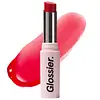What's inside
What's inside
 Key Ingredients
Key Ingredients

 Benefits
Benefits

 Concerns
Concerns

 Ingredients Side-by-side
Ingredients Side-by-side

Ricinus Communis Seed Oil
MaskingEthylhexyl Palmitate
EmollientCaprylic/Capric Triglyceride
MaskingPentaerythrityl Tetraisostearate
EmollientSynthetic Wax
AbrasiveMicrocrystalline Wax
Emulsion StabilisingPolybutene
Hydrogenated Microcrystalline Wax
Emulsion StabilisingMenthol
MaskingAroma
Helianthus Annuus Seed Wax
Skin ConditioningDicalcium Phosphate
AbrasiveSynthetic Fluorphlogopite
Silica Silylate
EmollientDisteardimonium Hectorite
StabilisingMenthyl Lactate
MaskingTribehenin
EmollientTocopheryl Acetate
AntioxidantHydrolyzed Sodium Hyaluronate
Skin ConditioningPentaerythrityl Tetra-Di-T-Butyl Hydroxyhydrocinnamate
AntioxidantSodium Saccharin
MaskingSorbitan Isostearate
EmulsifyingSodium Hyaluronate
HumectantHydrogenated Castor Oil
EmollientPersea Gratissima Oil
Skin ConditioningPalmitoyl Hexapeptide-12
Skin ConditioningLimonene
PerfumingCI 15850
Cosmetic ColorantIron Oxides
CI 19140
Cosmetic ColorantCI 42090
Cosmetic ColorantCI 77891
Cosmetic ColorantCI 15985
Cosmetic ColorantRicinus Communis Seed Oil, Ethylhexyl Palmitate, Caprylic/Capric Triglyceride, Pentaerythrityl Tetraisostearate, Synthetic Wax, Microcrystalline Wax, Polybutene, Hydrogenated Microcrystalline Wax, Menthol, Aroma, Helianthus Annuus Seed Wax, Dicalcium Phosphate, Synthetic Fluorphlogopite, Silica Silylate, Disteardimonium Hectorite, Menthyl Lactate, Tribehenin, Tocopheryl Acetate, Hydrolyzed Sodium Hyaluronate, Pentaerythrityl Tetra-Di-T-Butyl Hydroxyhydrocinnamate, Sodium Saccharin, Sorbitan Isostearate, Sodium Hyaluronate, Hydrogenated Castor Oil, Persea Gratissima Oil, Palmitoyl Hexapeptide-12, Limonene, CI 15850, Iron Oxides, CI 19140, CI 42090, CI 77891, CI 15985
Polybutene
Bis-Behenyl/Isostearyl/Phytosteryl Dimer Dilinoleyl Dimer Dilinoleate
EmollientSimmondsia Chinensis Seed Oil
EmollientDiisostearyl Malate
EmollientPolyethylene
AbrasiveTriisostearyl Citrate
EmollientC12-15 Alkyl Lactate
EmollientEuphorbia Cerifera Wax
Pentaerythrityl Tetraisostearate
EmollientTrimethylolpropane Triisostearate
EmollientLimnanthes Alba Seed Oil
Skin ConditioningOctyldodecanol
EmollientTridecyl Trimellitate
EmollientSucrose Acetate Isobutyrate
Synthetic Fluorphlogopite
Sodium Hyaluronate
HumectantHelianthus Annuus Seed Wax
Skin ConditioningCitrullus Lanatus Seed Oil
EmollientTribehenin
EmollientRicinus Communis Seed Oil
MaskingTocopheryl Acetate
AntioxidantButyrospermum Parkii Nut Extract
EmollientHydrated Silica
AbrasiveLecithin
EmollientEthylhexyl Palmitate
EmollientCaprylic/Capric Triglyceride
MaskingPalmitoyl Tripeptide-1
Skin ConditioningLactic Acid
BufferingAscorbyl Palmitate
AntioxidantPentaerythrityl Tetra-Di-T-Butyl Hydroxyhydrocinnamate
AntioxidantTocopherol
AntioxidantSorbitan Oleate
EmulsifyingSorbitan Isostearate
EmulsifyingCaprylyl Glycol
EmollientCI 15850
Cosmetic ColorantTitanium Dioxide
Cosmetic ColorantIron Oxides
CI 42090
Cosmetic ColorantCI 45410
Cosmetic ColorantCI 19140
Cosmetic ColorantCI 15985
Cosmetic ColorantPolybutene, Bis-Behenyl/Isostearyl/Phytosteryl Dimer Dilinoleyl Dimer Dilinoleate, Simmondsia Chinensis Seed Oil, Diisostearyl Malate, Polyethylene, Triisostearyl Citrate, C12-15 Alkyl Lactate, Euphorbia Cerifera Wax, Pentaerythrityl Tetraisostearate, Trimethylolpropane Triisostearate, Limnanthes Alba Seed Oil, Octyldodecanol, Tridecyl Trimellitate, Sucrose Acetate Isobutyrate, Synthetic Fluorphlogopite, Sodium Hyaluronate, Helianthus Annuus Seed Wax, Citrullus Lanatus Seed Oil, Tribehenin, Ricinus Communis Seed Oil, Tocopheryl Acetate, Butyrospermum Parkii Nut Extract, Hydrated Silica, Lecithin, Ethylhexyl Palmitate, Caprylic/Capric Triglyceride, Palmitoyl Tripeptide-1, Lactic Acid, Ascorbyl Palmitate, Pentaerythrityl Tetra-Di-T-Butyl Hydroxyhydrocinnamate, Tocopherol, Sorbitan Oleate, Sorbitan Isostearate, Caprylyl Glycol, CI 15850, Titanium Dioxide, Iron Oxides, CI 42090, CI 45410, CI 19140, CI 15985
 Reviews
Reviews

Ingredients Explained
These ingredients are found in both products.
Ingredients higher up in an ingredient list are typically present in a larger amount.
This ingredient is an emollient, solvent, and texture enhancer. It is considered a skin-softener by helping the skin prevent moisture loss.
It helps thicken a product's formula and makes it easier to spread by dissolving clumping compounds.
Caprylic Triglyceride is made by combining glycerin with coconut oil, forming a clear liquid.
While there is an assumption Caprylic Triglyceride can clog pores due to it being derived from coconut oil, there is no research supporting this.
Learn more about Caprylic/Capric TriglycerideCi 15850 is the pigment color red. It is an azo dye and created synthetically.
Azo dyes need to be thoroughly purified before use. This allows them to be more stable and longer-lasting.
This ingredient is common in foundations, lipsticks, and blushes. This color is described as brown/orangey red.
It has many secondary names such as Red 6 and Red 7. According to a manufacturer, Red 6 usually contains aluminum.
Learn more about CI 15850Ci 15985 is a dye made from petroleum. It is synthetically created and approved by the FDA for use in foods and cosmetics.
The color of this dye is orange/yellow.
This ingredient can be found in makeup, sun care, and skincare.
Learn more about CI 15985CI 19140 is also known as Tartrazine. Tartrazine is a synthetic dye used in cosmetics, foods, and medicine to add a yellow color.
Tartrazine is created from petroleum and is water-soluble.
Some people may experience allergies from this dye, especially asthmatics and those with an aspirin intolerance.
Learn more about CI 19140Ci 42090 is a synthetic dye created from petroleum. It is used to give a bright blue color to cosmetics, medicine, and food.
Ethylhexyl Palmitate, also known as octyl palmitate, is created from 2-ethylhexyl alcohol and palmitic acid. It is a fatty acid ester.
The fatty acid content of Ethylhexyl Palmitate makes it an emollient. Emollients help soften and hydrate your skin by trapping moisture within.
Ethylhexyl Palmitate is also used to help improve the texture of cosmetics. It helps other ingredient dissolve in products and help disperse ingredients more evenly.
You'll likely find this ingredient in sunscreen, as it is often used to mix UV-blocking ingredients such as avobenzone and ethylhexyl triazone.
It can also help stabilize the fragrances in a product as a fragrance fixative.
Ethylhexyl Palmitate can be used to substitute mineral oil.
Due to its high fatty acid content, it may not be fungal-acne safe.
Learn more about Ethylhexyl PalmitateHelianthus Annuus Seed Wax is created from the common sunflower.
Sunflower seed wax is made up of long chain non-glyceride esters, a small amount of fatty alcohols, and fatty acids.
This ingredient is often used to enhance the texture of products. The fatty acid properties also help hydrate the skin.
Learn more about Helianthus Annuus Seed WaxPentaerythrityl Tetra-Di-T-Butyl Hydroxyhydrocinnamate (long name, huh?) is a synthetic antioxidant.
It is used to help stabilize other antioxidants or prevent the color from changing in a product.
As an antioxidant, it helps fight free-radical molecules. Free-radical molecules are capable of damaging our cells and other genetic material. Thus, antioxidants may reduce the signs of aging.
This ingredient is oil-soluble.
Learn more about Pentaerythrityl Tetra-Di-T-Butyl HydroxyhydrocinnamatePentaerythrityl Tetraisostearate is derived from isostearic acid. It is an emollient and emulsifier.
The highest concentration of this ingredient is found in lipsticks.
This ingredient is minimally water soluble and may not be Malassezia folliculitis, or fungal-acne safe.
Learn more about Pentaerythrityl TetraisostearatePolybutene is used to help control the viscosity of a product. This just means it helps adjusts the texture.
It is a polymer and does not get absorbed into the skin due to its large size.
Studies found this ingredient did not irritate skin in concentrations below 15%.
Learn more about PolybuteneRicinus Communis Seed Oil is the INCI name for castor oil.
Castor Oil helps moisturize the skin. It is rich in a fatty acid called ricinoleic acid. This fatty acid helps prevent moisture loss on the skin. This helps keep your skin soft and hydrated. Ricinoleic acid also has anti-inflammatory and pain reducing properties.
Besides hydrating the skin, castor oil is also used to hydrate hair. By keeping the hair shaft moisturized, breakage is decreased. More studies are needed to show castor oil's effective on stimulating hair growth.
Castor oil is created by cold-pressing castor seeds and then purifying the oil with heat. It was used in Ancient Egypt as fuel in lamps and to help treat eye irritation.
The term 'fragrance' is not regulated in many countries. In many cases, it is up to the brand to define this term. For instance, many brands choose to label themselves as "fragrance-free" because they are not using synthetic fragrances. However, their products may still contain ingredients such as essential oils that are considered a fragrance.
Learn more about Ricinus Communis Seed OilSodium Hyaluronate is hyaluronic acid's salt form. It is commonly derived from the sodium salt of hyaluronic acid.
Like hyaluronic acid, it is great at holding water and acts as a humectant. This makes it a great skin hydrating ingredient.
Sodium Hyaluronate is naturally occurring in our bodies and is mostly found in eye fluid and joints.
These are some other common types of Hyaluronic Acid:
Learn more about Sodium HyaluronateSorbitan Isostearate is an emulsifer and cleaning agent. It is created from isostearic acid and sorbitol.
As an emulsifier, Sorbitan Isostearate prevents oils and water from separating.
Due to its isostearic acid base, it may not be safe for Malassezia or fungal acne.
Learn more about Sorbitan IsostearateSynthetic Fluorphlogopite is the synthethic version of mica. It consists of fluorine, aluminum and silicate.
Synthetic Fluorphlogopite is used to add volume to products.
It is considered non-irritating on the skin.
Learn more about Synthetic FluorphlogopiteTocopheryl Acetate is AKA Vitamin E. It is an antioxidant and protects your skin from free radicals. Free radicals damage the skin by breaking down collagen.
One study found using Tocopheryl Acetate with Vitamin C decreased the number of sunburned cells.
Tocopheryl Acetate is commonly found in both skincare and dietary supplements.
Learn more about Tocopheryl AcetateTribehenin comes from glycerin and behenic acid.
It is used as an emollient, or moisturizer. Emollients form a thin barrier on skin to prevent moisture from escaping.
This ingredient may not be Malassezia folliculitis, or fungal-acne safe.
Learn more about TribeheninThis ingredient is a combination of red, black, and yellow iron oxide pigments. This combination of colors is usually found in foundation, because it results in a "skin" color.